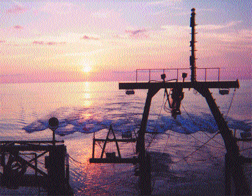 At any given
time, magma is welling up from deep within Earth to spread and create new crust
at the seafloor. At these ridges, nutrients fuel microbial communities, and
heat is transferred to the seafloor. Different spreading ridges move at different
rates, however, and new research may explain how changes in spreading rates
affect heat distribution and crust development at the ridges, particularly the
slow ones.
At any given
time, magma is welling up from deep within Earth to spread and create new crust
at the seafloor. At these ridges, nutrients fuel microbial communities, and
heat is transferred to the seafloor. Different spreading ridges move at different
rates, however, and new research may explain how changes in spreading rates
affect heat distribution and crust development at the ridges, particularly the
slow ones.The R/V Maurice Ewing tows an airgun array during an experiment to study the varying spreading rates at an ocean ridge in the western Atlantic Ocean. One airgun hangs 23 feet beneath each of the orange buoys. Image courtesy of Dan Lizarralde.
In 2003, scientists from the Woods Hole Oceanographic Institution classified a new category of “ultraslow”-spreading mid-ocean ridges, which spread at less than 20 millimeters per year and make about one-third of the 55-kilometer-long mid-ocean ridge system that loops around the planet. They concluded that the ultraslow-spreading ridges work under a dramatically different set of rules than slow-spreading ridges, which move 20 to 55 millimeters per year, as well as faster-spreading ridges, which move up to 180 millimeters per year and are usually found in the Pacific. The ultraslow-spreading ridges produce less crust, which scientists believed to be the result of less melt and cooler temperatures within the mantle.
To test that idea, Daniel Lizarralde of the Georgia Institute of Technology, along with colleagues from Columbia University’s Lamont-Doherty Earth Observatory and Woods Hole, has taken a look beyond the mid-ocean ridge. Working southwest of Bermuda in the western Atlantic Ocean, Lizarralde and his team studied the geochemical “fingerprint” of an 800-kilometer-long upper-mantle segment, spanning 35 million years, that has since moved away from the ridge and cooled down.
Reporting in the Dec. 9 Nature, the research team says that ultraslow-spreading ridges still produce melt, but that the melt does not efficiently upwell at the ridge. This process explains why the crust is thinner in ultraslow-spreading ridges. “There’s a lot of melt that doesn’t get out at slow spreading rates,” Lizarralde says, “and that’s not in the [previous] models.” Thus, the changes in spreading rate are more likely to affect the buoyancy of the mantle and the ability of the melt to flow outward, rather than affecting the amount of melt produced.
Lizarralde says that molten rock not directly aligned below the ridge has a distinct chemical composition and is more likely to get stuck in the mantle as the spreading rate slows. As a result, the melt that does get out to the seafloor has a different chemical makeup than normal, which helps to explain geochemical variations in the crust.
Lizarralde, an active-source seismologist, fired off blasts from 20 airguns at six-minute intervals and used seafloor seismometers to estimate the composition of the crust and upper mantle. He says no one had ever done airgun surveys with such long repetition time intervals, which allowed him to record energy from 375 kilometers away from the airgun source and 40 kilometers below the ocean.
Henry Dick of Woods Hole says that his group found similar geochemical variations in the mantle at the ultraslow Gakkel Ridge beneath the Arctic Ocean between Greenland and Siberia, supporting Lizarralde’s results. But, Dick says, his team’s findings, which also correlate crustal thickness and melt production, contradict Lizarralde’s conclusions. “We have an enigma going on right now,” Dick says. “There’s very firm evidence on both sides of the issue.”
Lizarralde plans to go to the Pacific Ocean next, and test his ideas on faster-spreading ridges.
Joshua Zaffos
Geotimes contributing writer
Back to top

